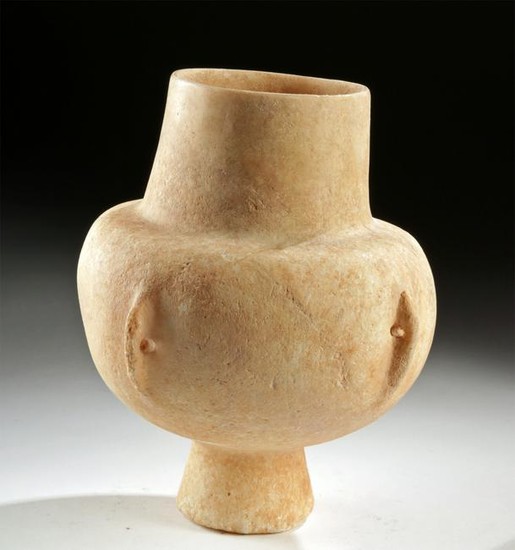Superb / Early Cycladic Marble Vessel - Kandila Form
Greece, Cycladic culture, probably Early Cycladic, ca. 3200 to 2800 BCE. A really fine example of a famous and rare ancient form, the kandila. This is a hollowed out, roughly spheroid bowl standing on a flaring pedestal foot. Four lug handles stud the sides, each roughly 90 degrees from the next. The neck is large and cylindrical, rounded, unpronounced rim around the mouth. The surface has been smoothed, probably using sandstone, and is a warm brown marble color with a reddish tinge from earthen deposits. This type of vessel is so named because it bears a strong resemblance to Greek church lamps. They seem to have been very popular forms during the Early Cycladic I period. They were made to hold liquids like oil or wine and could be suspended for storage from the holes drilled through the handles. Size: 7.25" W x 8.95" H (18.4 cm x 22.7 cm)
The Cycladic Islands, located in the southwestern Aegean Sea, are rich in mineral resources, and as the Early Bronze Age began, ca. 3000 BCE, their iron and copper ores created local wealth. Artisans worked in stone, creating beautiful vessels like this one and the mysterious marble idols known as kilia. These marble objects ultimately wound up in tombs, and they have been found in burial sites in varying quantities - suggesting social stratification based on personal wealth, an important development in the formation of societies. The surface of these marble objects would have been painted with bright mineral pigments - blue azurite and red cinnabar.
See several similar examples at Christie's selling for between $9,450 and $269,000:
http://www.christies.com/lotfinder/Lot/a-cycladic-marble-kandila-early-cycladic-i-ii-5800572-details.aspx
http://www.christies.com/lotfinder/Lot/a-cycladic-marble-kandila-early-cycladic-i-5800577-details.aspx/
http://www.christies.com/lotfinder/Lot/a-cycladic-marble-kandila-early-cycladic-i-5609513-details.aspx
http://www.christies.com/lotfinder/Lot/a-cycladic-marble-kandila-early-cycladic-i-ii-5926269-details.aspx
Provenance: ex-Janet & George Zakos, Geneva, Switzerland 1970s
All items legal to buy/sell under U.S. Statute covering cultural patrimony Code 2600, CHAPTER 14, and are guaranteed to be as described or your money back.
A Certificate of Authenticity will accompany all winning bids.
We ship worldwide to most countries and handle all shipping in-house for your convenience.
#146579 Dimensions: Condition Report: Expertly repaired and restored from approximately ten medium-to-large pieces. With added adhesive/pigment along the break lines. Weathering on stone surface with some small chips and scratches commensurate with age and deposits overall.
View it on
Estimate
Time, Location
Auction House
Greece, Cycladic culture, probably Early Cycladic, ca. 3200 to 2800 BCE. A really fine example of a famous and rare ancient form, the kandila. This is a hollowed out, roughly spheroid bowl standing on a flaring pedestal foot. Four lug handles stud the sides, each roughly 90 degrees from the next. The neck is large and cylindrical, rounded, unpronounced rim around the mouth. The surface has been smoothed, probably using sandstone, and is a warm brown marble color with a reddish tinge from earthen deposits. This type of vessel is so named because it bears a strong resemblance to Greek church lamps. They seem to have been very popular forms during the Early Cycladic I period. They were made to hold liquids like oil or wine and could be suspended for storage from the holes drilled through the handles. Size: 7.25" W x 8.95" H (18.4 cm x 22.7 cm)
The Cycladic Islands, located in the southwestern Aegean Sea, are rich in mineral resources, and as the Early Bronze Age began, ca. 3000 BCE, their iron and copper ores created local wealth. Artisans worked in stone, creating beautiful vessels like this one and the mysterious marble idols known as kilia. These marble objects ultimately wound up in tombs, and they have been found in burial sites in varying quantities - suggesting social stratification based on personal wealth, an important development in the formation of societies. The surface of these marble objects would have been painted with bright mineral pigments - blue azurite and red cinnabar.
See several similar examples at Christie's selling for between $9,450 and $269,000:
http://www.christies.com/lotfinder/Lot/a-cycladic-marble-kandila-early-cycladic-i-ii-5800572-details.aspx
http://www.christies.com/lotfinder/Lot/a-cycladic-marble-kandila-early-cycladic-i-5800577-details.aspx/
http://www.christies.com/lotfinder/Lot/a-cycladic-marble-kandila-early-cycladic-i-5609513-details.aspx
http://www.christies.com/lotfinder/Lot/a-cycladic-marble-kandila-early-cycladic-i-ii-5926269-details.aspx
Provenance: ex-Janet & George Zakos, Geneva, Switzerland 1970s
All items legal to buy/sell under U.S. Statute covering cultural patrimony Code 2600, CHAPTER 14, and are guaranteed to be as described or your money back.
A Certificate of Authenticity will accompany all winning bids.
We ship worldwide to most countries and handle all shipping in-house for your convenience.
#146579 Dimensions: Condition Report: Expertly repaired and restored from approximately ten medium-to-large pieces. With added adhesive/pigment along the break lines. Weathering on stone surface with some small chips and scratches commensurate with age and deposits overall.



